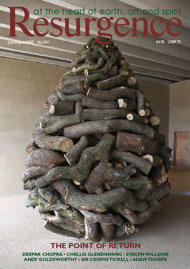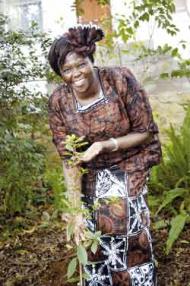IN 1981, WANGARI Maathai, a forty-one-year-old divorcee living in Nairobi, had so little money that she drove her three children over to her ex-husband’s house and deposited them with him. With no job, no pension and no home, her prospects, as she puts it in her new autobiography Unbowed, amounted to “zero”. All she had left was an idea.
Twenty-three years later, when she had turned the Green Belt Movement into a worldwide cause, had faced down the corrupt and authoritarian government of Daniel Arap Moi, and had brought women into the heart of the Kenyan political process, Wangari Maathai became the first African woman to be awarded the Nobel Peace Prize.
The idea that transformed her life and the lives of so many others was based on a simple premise: “Anyone can dig a hole, put a tree in it, water it, and nurture it.” This one gesture could combat soil erosion and desertification, retain rainwater, provide firewood and restore biodiversity. Maathai’s dream was to plant 15 million indigenous trees: one for every Kenyan. She more than exceeded her own target. So far, 30 million trees have been planted in Kenya alone.
Maathai’s extraordinary life began in 1940 in a mud-walled house with no electricity or running water. The foothills of the Aberdares were rich in shrubs, creepers and trees and each day her mother (who, naturally, had no fridge) harvested food, drew water from the stream, cooked on an open fire and told traditional Kikuyu stories. Her daughter slept on a plank with a bedcover filled with leaves, ferns and grass. As a child, Maathai writes, she grew up without “fear or uncertainty”.
Before the British, the main currency had been goats; after the British arrived, it was cash. By the 1950s, there were 40,000 settlers in the White Highlands, and Maathai’s tall, muscular father (a polygamist, incidentally, like many of his peers) was part of the first generation who left home in search of a job and money. The landscape was changing as rapidly as the social fabric, with indigenous trees giving way to large, fast-growing plantations of eucalyptus and pine.
Maathai’s own education mirrored that shift, taking her from a rural, non-literate society to a primary school with an earth floor and a tin roof. From there, she attended Catholic schools, where speaking English was compulsory. Across Kenya, the collision of cultures was producing violent upheaval: the Mau Mau Rebellion in the early 1950s led to votes for black Kenyans in 1957 and, in 1963, to Independence itself.
By then, Maathai was in the United States, one of 400 scholars who were part of the ‘Kennedy airlift’, which aimed to educate talented young Africans for a post-colonial world. Nearly everything in the States was new: Maathai had never seen escalators, or snow fall, or young men and women holding hands in the street. She drank soda, learned to dance the Twist and experimented with a hot comb on her hair.
She returned to Nairobi in 1966, wearing a red close-fitting A-line dress, and spent her first night at the New Stanley Hotel (unthinkable in pre-Independence Kenya). But a knock-out dress wasn’t all she brought back. There were the examples of JFK, Martin Luther King, the civil rights movement, sit-ins and teach-ins. “There is a persistence,” she writes, “a seriousness, and a vision to America.”
Her marriage to an aspiring young politician proved hard for a young female academic. It was considered acceptable for black politicians to adopt a European style, but their wives were supposed to project the couple’s Africanness. When Maathai became the first woman in East and Central Africa to receive a Ph.D., her critics called her “a white woman in black skin”.
Her post-doctoral research on East Coast fever took her back to rural Kenya where she was shocked to discover rivers muddy with silt and cows skinny from low-nutrient grass. She quickly grasped that the concerns local women expressed about water, energy and nutrition were social and environmentalones. It led her to found the Green Belt Movement with the aim of reversing deforestation and soil erosion.
Unbowed makes clear that the four decades of resolute campaigning have come at a high personal cost: divorce, unemployment, arrests, imprisonment, violent beatings and death threats. Each of Maathai’s campaigns, whether opposing the building of a massive tower block in Nairobi’s Uhuru Park or fighting the land-grabbing in the Karura Forest, has been based on long-term strategies that were built on winning the acceptance of local communities. “Education”, she writes, “should not take people away from the land.”
The approach that Maathai inspiringly outlines across these 300 pages always starts, literally, at the grass roots. From there it grows, through persistence, seriousness and vision. Planting trees was always about planting ideas.








